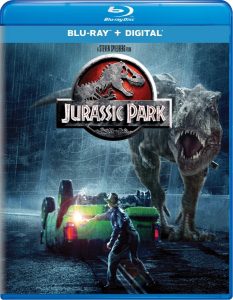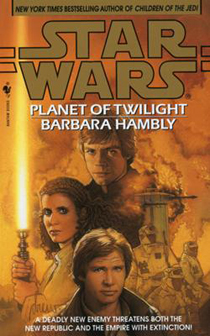In my re-read of the Bantam novels, I thought I was saving the worst for last with “Planet of Twilight” (1997). My 18-year-old self hated this novel, and I remember why: This is the final chapter of the Callista trilogy, following “Children of the Jedi” and “Darksaber,” and for a Callista-Luke ‘shipper, it’s a huge letdown. Even though Luke travels to Nam Chorios to track down his beloved, Callista doesn’t appear until two-thirds of the way through the novel. And Luke never does catch up to her, except for a distant goodbye wave in the closing pages.
Although my younger self’s reasons for disliking the novel are understandable (and shared by many other “Star Wars” fans, who tend to put this book on “worst of” lists), after this re-read, I feel like I owe author Barbara Hambly an apology. If one goes into “Planet of Twilight” knowing that there won’t be a Callista and Luke reunion, it reads a lot better. In fact, this is quite a meaty novel, and I now think it’s the best of the Callista trilogy – much better than Kevin Anderson’s cartoonish “Darksaber,” and also superior to Hambly’s “Children of the Jedi,” which was a slog during the Eye of Palpatine scenes.
Hambly’s poetic style of writing works well for describing Nam Chorios, a barren crystalline-plained planet infested with drochs, bugs that can bite and burrow into your skin but are ultimately harmlessly absorbed into your body. Although Joe Schreiber’s “Death Troopers” and “Red Harvest” are considered the only full-fledged works of “Star Wars” horror, Hambly writes some excellent horror sequences, including when Leia ventures into a dark stairwell beneath the house of Seti Ashgad, who has kidnapped her. At one point, she encounters a huge droch and begins to realize that these creatures can multiply in size by eating their own kind.
“Planet of Twilight’s” poetic horror sets the mood, but it has a lot of other stuff going on, including an exploration of the political climate of a Republic-Empire border sector. Forming a link with “Darksaber,” we get the surprise return of Admiral Daala in the final pages, and an even more surprising dose of romance for her. We also get the mystery surrounding Seti Ashgad, whose father Leia remembers as a powerful senator in the court of Palpatine and Vader, plus more suitably creepy villains (Dzym, a droch-turned-sentient-humanoid, really takes the cake!). We get darkly humorous passages following C-3PO and R2-D2’s frustrating attempts to reach a Republic world to get word out about the Death Seed plague.
We get meditations on the Force from Luke and Callista and Leia, who wins her first major lightsaber battle, against Beldorion the Hutt. (She uses a yellow-bladed saber, rather than the inappropriately red one in “The Corellian Trilogy.”) And Hambly writes fine dream sequences where people from Leia’s past and present play roles in illustrating her fears about Jedi training. (Yes, a Jedi fearing the Dark Side is a horrible cliché, but Hambly’s flowing prose freshens this old concept.)

And even the Luke-Callista stuff works in its own sadly beautiful way, as Luke comes to grips with the notion that – even though they love each other deeply – Callista (who lost her Force powers in “Children of the Jedi”) must find her own path, and he can’t be a part of it. Indeed, Hambly deftly writes herself – and the whole Bantam timeline – out of a tight spot caused by the books being written out of chronological order. Luke and Callista engaged in a whirlwind romance in “Children of the Jedi” and “Darksaber,” but she’s not mentioned at all in later (earlier-written) books such as “The Crystal Star” and “The Corellian Trilogy.” But Hambly couldn’t dramatically kill off Callista, because that would be something that should weigh on Luke’s psyche in later novels. So she had to break them apart in a way that leaves Luke’s mind at ease.
It’s also likely that, as she was writing “Planet of Twilight,” Hambly knew about Timothy Zahn’s plan to pair Luke and Mara in “Vision of the Future” (1998). “The Essential Readers’ Companion” notes that Anderson and Rebecca Moesta were instructed to not mention Luke’s marriage to Mara in the “Young Jedi Knights” books so as to avoid spoiling the surprise in “Vision of the Future,” and presumably Hambly – who was loosely collaborating on this Callista trilogy with Anderson — was let in on the Luke-and-Mara plan, too.
The bitter reality of Luke and Callista’s breakup was unavoidable, so all Hambly could do was add enough sweetness to create a bittersweet novel. After this re-read, I have to say she succeeded, and although she’s unlikely to be invited back into the fold, I’d love to read more of Hambly’s takes on “Star Wars” in the future.
(P.S.: Why the hell are there Hoth rebel soldiers on the cover? While Drew Struzan’s artwork is undeniably good from an artistic perspective, it’s a continuing shame that “Star Wars” novels fail to convey specifics of what happens in a given book. For instance, Hambly writes a wonderful dream sequence where Leia imagines two potential selves in a showdown – a meek Slave Leia from Jabba’s palace, and a powerful Dark Side Leia wearing the Emperor’s robes. A cover image of that scene would be a more accurate reflection of the content, and maybe even sell more books, than the standard rehash of publicity photos and trilogy scenes.)

